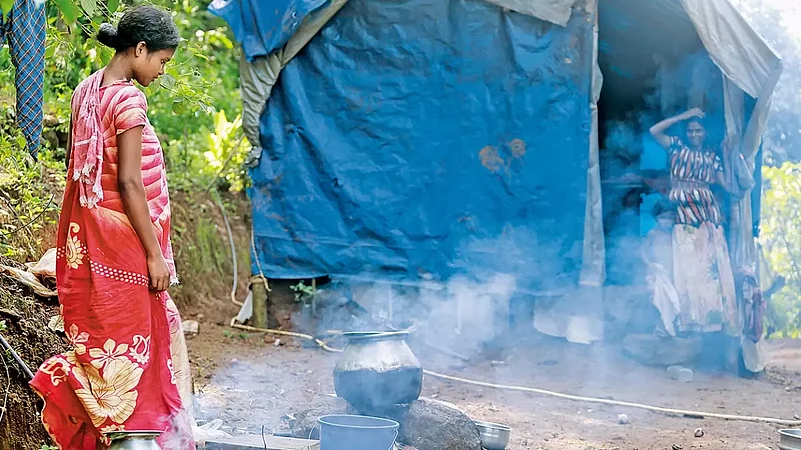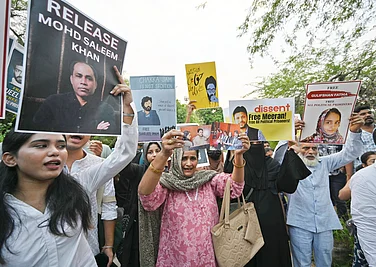Nanchiyamma of the Nakkuppathi tribal settlement of Attappady hamlet in Kerala is not just a name anymore. She is the first Adivasi woman to win the national film award for the best playback singer. Before the awards for the year 2020 were declared last July, Nanchiyamma had hit the headlines for other reasons as she alleged that her ancestral property was arrogated by some people. “A few years back the land owned by my grandfather was usurped by some people and they are preventing us from entering the property. We are unable to cultivate the land as a legal suit is pending. When we are finding it difficult to make two ends meet, how can we fight these mighty people in courts?” asks the singer.
When Nachiyamma came out in open with these accusations, the government machinery woke up from the slumber and offered some possible solution, but that too is yet to be materialised. As Nanchiyamma herself rightly mentioned, it was not her story only but of a community which has been robbed off its land.
According to the 2011 Census, the tribals of Kerala account for about 1.45 per cent of the population with Wayanad, Idukky and Palakkad districts taking the lion’s share of the native tribal groups. The geographically concentrated group is profusely rural and lacks basic amenities as the much celebrated Kerala model of development has made little impact to change their status. As per the Scheduled Tribe Department, around 8,000 tribal families across the state were landless in 2020–21.
Twenty years of Muthanga Police Firing
It has been almost 20 years since the police opened fire to evict the Adivasis who had occupied the Muthanga wildlife sanctuary of Wayanad district in northern Kerala. They were protesting against the delay in distribution of land the state government had promised them after a 48 days long agitation before the state secretariat. The incident in which Jogi, an Adivasi protestor, and Vinod, a policeman, lost their lives had been a watershed moment in the history of land struggles in Kerala.
Years later, tribal activists say that nothing has changed as the government kept on backtracking from one agreement after another agreement. Most of the Adivasi families still live without having a piece of land. “No government has real interest in taking up our issues,” says K. Ammini, a tribal activist from Wayanad. Elsewhere in Mariyanad, Irulam and Thovarimala, tribal organisations are demanding government land to be distributed among them, citing court orders. “You can see hundreds of families that do not have title deeds in the ‘One Lakh Houses’ colonies that are constantly in news for the lack of basic amenities. Landlessness is more lethal than any other endemic among the Adivasis,” observes Ammini. The ‘One Lakh Houses’ was a unique housing project pioneered by the Kerala Government way back in 1972.
“What we demand is not some fancy government projects, but the proper implementation of the Forest Rights Act,” says Chitra Nilambur, another tribal activist from Malappuram district. “Government projects do not do any good for the community as they serve as avenues of corruption for officials. If the act is implemented, it will empower us. This is precisely why the government is not keen to effectuate it,” points out Chitra. Though the government has given land to some tribals under the individual right category of the act, community rights are still a no-no for the tribal people, she adds.
The state Revenue Department regularly organises title deed fests but no follow-up action is taken. There are many tribal people who got the papers but do not know where the said piece of land was.

For instance, Kumar of Vazhavatta got a memo from the Revenue Department last year, seeking explanation for not occupying ‘the land allotted to him’. “I was not intimated that I have been given a possession document of some land or property,” wonders Kumar. As per records, he had been allotted 10 cents of land in Chundel near Vythiri of Wayanad, but it was never communicated to him.
Kalloor Kesavan, an activist at the forefront of many land struggles, has another sad story to narrate. He fought a long legal battle for the rights of 62 SC and ST families over the surplus land the government had offered to them in 1976. Despite an order from the Kerala High Court, they are yet to get the land after 45 years. “In fact, we were offered alternate land for this surplus land as it was no longer available due to arrogation and encroachment by various people. Interestingly, the families under general category had got the land way back in the 1970s. Of the 62 initial applicants, only 42 are alive now,” says Kesavan.
After the Muthanga incident, there were a dozen of cases against hundreds of Adivasi activists. There were inquiries and investigations by the National Human Rights Commission, SC/ST Commission and National Commission for Women. But the state government tactfully referred the case to the Central Bureau of Investigation, which eventually turned against the Adivasi activists. M. Geethanandan, one of the founders of the Adivasi Gotra Maha Sabha (AGMS), says, “We had to fight endless battles in the courts and many of the cases are still going on. The left parties, which were in Opposition then, took up the matter in a different way, highlighting the police atrocity only and effectively shifting the focus from the issue of the alienated land.”
The Hollowness of Land Reforms
The history of alienation of Adivasi land in Kerala dates back to the British period. The British came looking for timber and other resources from the woods, flushing out the forest dwellers, the Adivasis. Subsequently, the feudal lords were introduced as the British handed over the ownership of the land. The entry of the feudal lords in to the woods was instrumental in the introduction of private property system, which further escalated the arrogation and expropriation of the Adivasi land.
It was after a long struggle and several efforts from various agrarian workers’ organisations that a bill for equitable distribution of land was introduced by the then Communist government in Kerala. The Agrarian Relations Act of 1958 was the cornerstone of land reforms in the state. More laws were passed in 1963–64 and 1969. The Kerala Land Reforms (Amendment) Act of 1969, which came into force in 1970, was in principle aimed to ensure land for the landless. According to this law, which was considered revolutionary by the Left, surplus and revenue forest land was to be distributed among the landless. However, this never happened, resulting in a huge number of landless people in the state. The Adivasis, who were evicted from their homeland inside the forests, were the worst affected.
The Controversial Bill of 1999
In 1975, the Kerala government unanimously enacted the Scheduled Tribes (Restriction of Alienated Land), assuring the restoration of all land lost by tribal people from January 26 ,1960. Actually, Parliament had passed a law making it mandatory for the state to restore alienated lands to the Adivasis. CPI leader, C. Achutha Menon was the chief minister then, and EMS Namboothiripad of the CPI(M) the Opposition leader. This amendment was kept in abeyance until 1986 as none of the political parties was keen on it.
Almost 25 years later, the state Assembly came up with yet another amendment, in favour of the settler farmers, who were the beneficiaries of land deals. The law was supported by all MLAs except K.R. Gowri Amma, who had introduced the Agrarian Relations Bill in 1958. By then, she had broken away from the CPI(M) and formed her own party JSS. The amendment legitimised all the land transactions up to 1986 involving tribal people, triggering huge protests from the Adivasi community.
It was after this amendment that the Adivasi land struggle in Kerala gained momentum. The AGMS, the grand council of the Adivasis, was formed in 2000 putting forward the slogan, “Land for the Landless”, under the leadership of Adivasi and Dalit leaders C.K. Janu and M. Geethanandan.
After 30 Adivasis reportedly died of starvation in 2000–2001, the Adivasi–Dalit Protest committee took the struggle into the state capital. A 48-day-long agitation, during which they erected shacks outside the state Secretariat and the chief minister’s official residence, forced the government to the negotiation table.
Now, after two decades of the Muthanga struggle, tribal organisations in Kerala are once again gearing up to intensify their agitation. Their demands remain the same, which include provision of land to the landless tribal families involved in the 2003 agitation.
(This appeared in the print edition as "The Hollowness of Land Reforms")
(Views expressed are personal)
Rajeev Ramachandran is a Kochi-based independent journalist and author





















